SAP SuccessFactors is cloud-based human capital management (HCM) software that provides tools for recruiting, performance management, talent management, and other employee-centric solutions. It also provides core employee management capabilities in the Employee Central module.
In many cases, when companies plan to move parts of their HCM processes to the cloud, a phased approach might be the solution of choice. Either the company first moves only parts of the HCM processes to the cloud (e.g., recruitment) and keeps the core functions located in the on-premise landscape, or they prefer to migrate their HCM solution successively to the cloud, based on certain locations. In any case, a seamless and tight integration between the processes running in the cloud and in the on-premise environment is critical.
As an example of the separation of processes between the on-premise landscape and the cloud, a company might want to run its recruitment processes using SAP SuccessFactors in the cloud, whereas core employee management functions are kept in the on-premise SAP ERP Human Capital Management (SAP ERP HCM) application. The following figure shows the involved components at a high level.
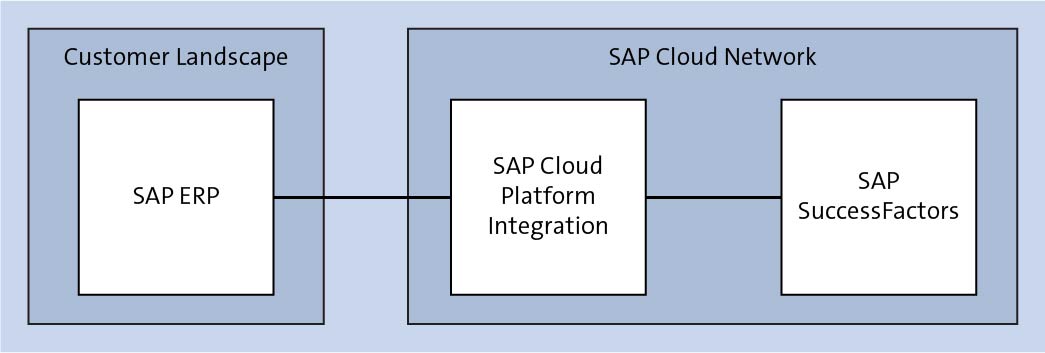
SAP SuccessFactors integration with SAP ERP is cloud-to-on-premise.
In the Integration Content Catalog, you can find various integration packages that facilitate the integration of SAP ERP-based processes with the cloud-based HCM processes of SAP SuccessFactors.
Technical Landscape
Below shows a common setup of an SAP SuccessFactors and SAP ERP integration scenario.
An obvious option to connect the SAP ERP with SAP Cloud Platform Integration is using web services communication (through the SOAP adapter).

For the other side of the communication, SAP SuccessFactors offers various API options to technically integrate with and connect to other systems, including the following:
- SFAPI: This is a SOAP API designed to import or export data to and from SAP SuccessFactors. It allows you to perform create, read, update, delete (CRUD) operations on SAP SuccessFactors entities.
- OData API: This API allows you to access SAP SuccessFactors content using OData.
SAP Cloud Platform Integration provides an option to use these APIs in an intuitiveand convenient way: the SAP SuccessFactors adapter, which is part of the SAP Cloud Platform Integration standard adapter offering.
SAP SuccessFactors Adapter
The SAP SuccessFactors adapter comes in several variants, depending on which API you want to connect to the SAP SuccessFactors system with (and the communication direction). Here is a list of these variants.
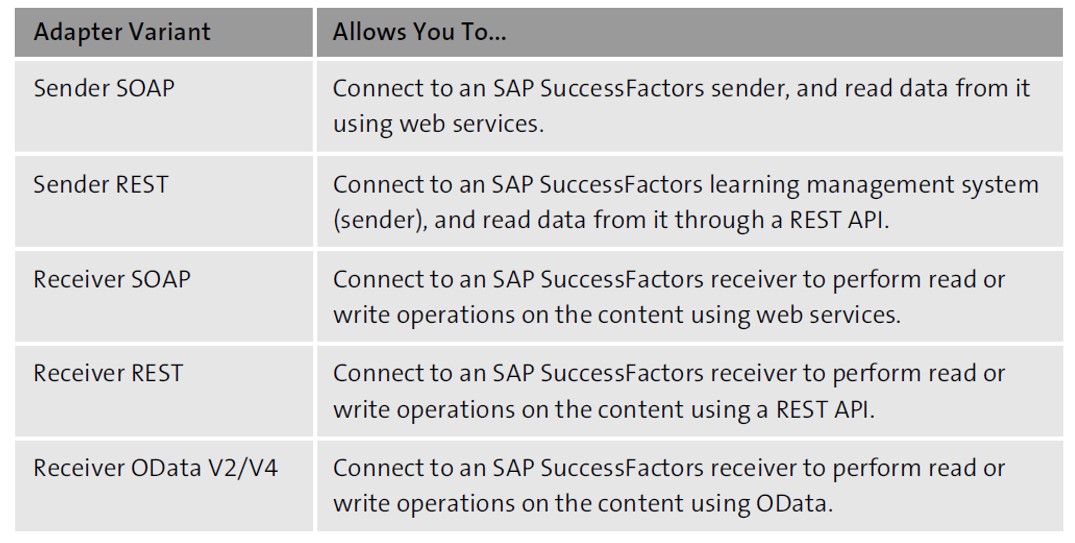
Each SAP SuccessFactors adapter type provides a dedicated configuration UI to access SAP SuccessFactors entities intuitively. After you’ve specified an SAP SuccessFactors system to connect to, through the configuration UI of the adapter, you can easily select the entities and define certain operations on them without the need to write any line of code. When you add an SAP SuccessFactors adapter to an integration flow, you’ll choose the corresponding variant by selecting a Message Protocol, as shown below, for a SAP SuccessFactors receiver adapter.
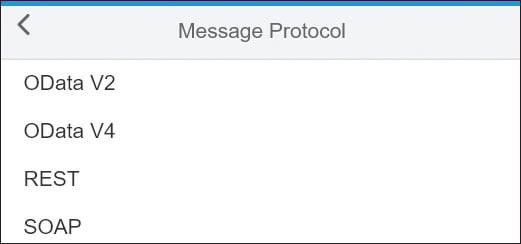
The detailed properties of the adapter’s configuration UI depend on the chosen message protocol. The following figure shows an example for a SAP SuccessFactors adapter configuration UI for a receiver adapter when you’ve selected SOAP as the Message Protocol. Some key properties are indicated and explained next.
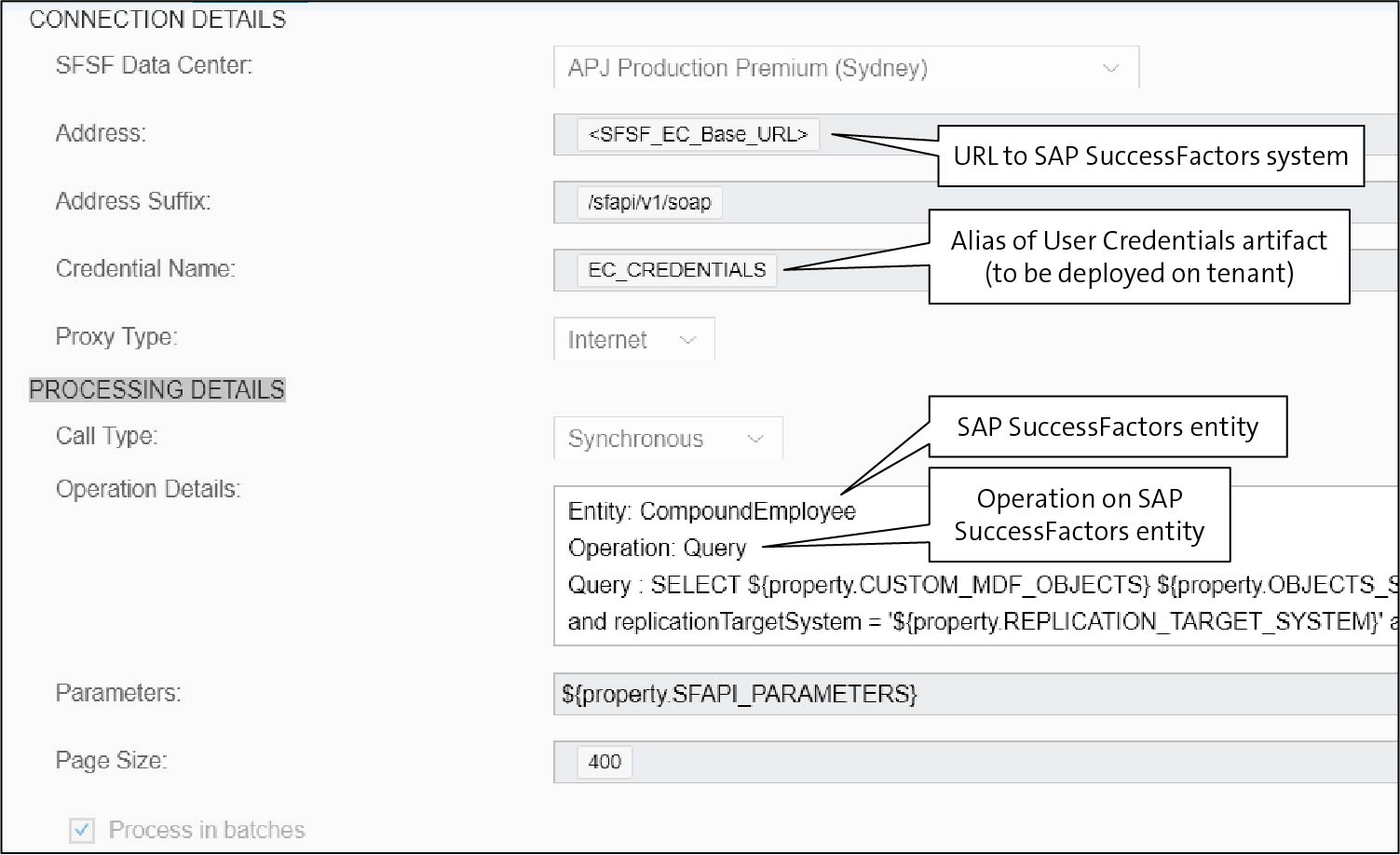
Note that the example shown is retrieved from the Integration Content Catalog and reflects the component version 1.1 of the SAP SuccessFactors adapter. In the meantime, updates to this adapter type have been provided so that, when you create a new SAP SuccessFactors receiver adapter (with the SOAP message protocol), you’ll get a slightly different UI (with the settings now spread on two different tabs Connection and Processing).
When you configure an SAP SuccessFactors sender adapter (to connect to an SAP SuccessFactors sender system), you can specify only query operations. This is because the SAP SuccessFactors adapter acts as a polling adapter, reading information at scheduled intervals from the SAP SuccessFactors system.
For receiver adapters, all standard CRUD operations of SFAPI (query, insert, upsert, update) are supported and can be configured, as shown above.
To configure a secure connection between SAP Cloud Platform Integration and an SAP SuccessFactors sender or receiver system, you’ll use the User Credentials artifact type, which comprises a username, password, and, specific to SAP SuccessFactors, a company ID (to indicate the SAP SuccessFactors system you’re connecting to).
When configuring the connection, you first define a User Credentials artifact and deploy it on the tenant, and, second, refer to the alias of the artifact (in the Credential Name field) in the SAP SuccessFactors adapter.
Below shows the properties of the User Credentials artifact to be deployed on the tenant to configure a secure connection between the tenant and an SAP SuccessFactors system.
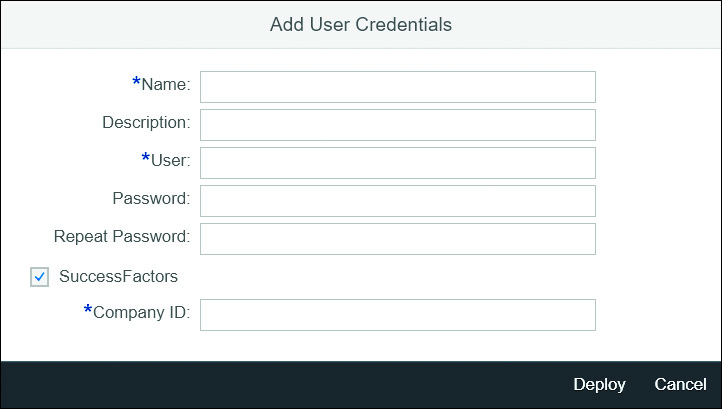
For SAP SuccessFactors sender adapters, you can also, for example, select a scheduler to specify that the adapter reads data from the SAP SuccessFactors (sender) system at certain time intervals.
Conclusion
SAP SuccessFactors integration doesn’t need to be hard. For those looking to utilize this cloud solution with an existing on-premise SAP ERP HCM system, this blog post should prove helpful as it provides a look at the technical landscape of an integration and the adapters used to view the SAP SuccessFactors UI.
This content was originally posted on the SAP PRESS Blog and has been adapted from a section of the book SAP Cloud Platform Integration: The Comprehensive Guide by John Mutumba Bilay, Peter Gutsche, Mandy Krimmel, and Volker Stiehl. Used with permission of SAP PRESS. All rights reserved.
